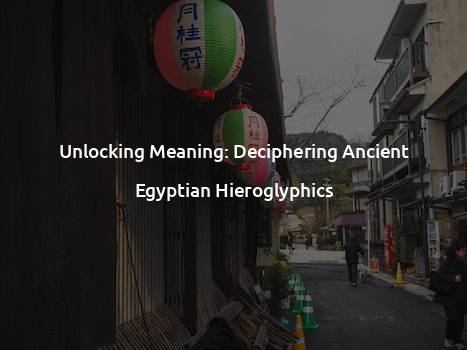Unlocking Meaning: Deciphering Ancient Egyptian Hieroglyphics
Deciphering ancient Egyptian hieroglyphics is like uncovering a hidden treasure trove of knowledge and understanding. These intricate symbols offer a glimpse into the rich culture and civilization that existed thousands of years ago in the land of the pharaohs. Unlocking the meaning behind these hieroglyphics has been a fascinating journey, allowing historians and archaeologists to piece together the puzzle of Egypt’s past.
The Origins of Hieroglyphics
Hieroglyphics, which literally means “sacred carvings,” are a system of writing consisting of pictorial symbols. The earliest hieroglyphics date back to around 3,300 BCE, during the Early Dynastic Period of ancient Egypt. However, this form of writing evolved over time and reached its peak during the New Kingdom (16th – 11th century BCE).
Initially, hieroglyphics were primarily used for religious and monumental inscriptions, such as those found on temple walls and tombs. Over time, they expanded their usage to include administrative documents, personal letters, and literary texts.
The Hieroglyphic Alphabet
Hieroglyphics consist of both determinatives (symbolic signs indicating the category or meaning of a word) and phonograms (symbols representing sounds). The script depicts both consonants and vowels, making it a complex system that required extensive knowledge to decipher.
Within the hieroglyphic alphabet, there are approximately 750 individual signs, some representing whole words or concepts while others represent individual sounds. The symbols range from simple shapes like animals and objects to more complex abstract representations.
Translating the Hieroglyphics
The first major breakthrough in deciphering hieroglyphics occurred in 1799 when a French soldier named Pierre-François Bouchard discovered the Rosetta Stone in the Egyptian town of Rosetta. This monumental discovery contained a decree issued by King Ptolemy V in 196 BCE, written in three scripts: hieroglyphics, demotic script, and Greek.
The Rosetta Stone, now housed in the British Museum, provided the key to unlocking the secrets of hieroglyphics. By comparing the Greek text, which was already understood, with the hieroglyphic inscriptions, scholars were able to identify common patterns and begin to decipher the meaning behind the symbols.
One of the key breakthroughs in deciphering hieroglyphics was the realization that some symbols represented not only sounds but also words or concepts. Hieroglyphics, it turned out, were a combination of phonetic and ideographic signs, with some signs representing more than one sound or word.
Building on the work of many scholars over the years, French Egyptologist Jean-François Champollion finally cracked the code in 1822. Champollion relied heavily on the Rosetta Stone and his understanding of the Coptic language, a descendant of ancient Egyptian, to decipher the hieroglyphics. His breakthrough opened the door to a wealth of knowledge about ancient Egyptian civilization.
The Meanings Behind the Symbols
The symbols used in hieroglyphics can have multiple meanings depending on the context in which they are used. For example, the symbol of an eye can represent the concept of seeing, but it can also be used to represent the sun or the god Horus.
Similarly, an image of a seated figure with an ankh (the symbol of life) in one hand can represent a specific deity, such as Osiris or the pharaoh. Understanding the religious beliefs and mythology of ancient Egypt is crucial in deciphering the deeper meanings behind these symbols.
Pharaohs often had complex royal names and titles, which were represented by a combination of symbolic signs. These signs included representations of gods, animals, and objects that conveyed specific meanings tied to the pharaoh’s rule and divine connection.
The Legacy of Hieroglyphics
Deciphering ancient Egyptian hieroglyphics has allowed historians to reconstruct aspects of the civilization’s daily life, religion, government, and culture. It has also shed light on historical events, such as military campaigns and royal successions.
Hieroglyphics provide a unique window into an ancient world. They offer a tangible connection to a civilization that flourished thousands of years ago and continue to captivate modern-day audiences. The ability to unlock the meaning behind these complex symbols has enabled us to understand and appreciate the rich heritage of ancient Egypt.
TLDR;
Ancient Egyptian hieroglyphics are a system of writing consisting of pictorial symbols. These intricate symbols have been deciphered and provide valuable insights into Egypt’s rich history. The hieroglyphic alphabet consists of both determinatives and phonograms and requires extensive knowledge to decode. The Rosetta Stone was instrumental in deciphering hieroglyphics, and Jean-François Champollion finally cracked the code in 1822. The meanings behind hieroglyphic symbols can vary depending on the context, and understanding ancient Egyptian religion and mythology is crucial in deciphering their deeper meanings. Deciphering hieroglyphics has allowed historians to reconstruct aspects of ancient Egyptian civilization and gain a deeper understanding of their culture, daily life, and historical events.







